Fermenting Beer with White Labs WLP510 Bastogne Belgian Ale Yeast
Published: September 27, 2025 at 9:48:51 PM UTC
White Labs WLP510 Bastogne Belgian Ale Yeast is a liquid ale culture designed for Belgian and high-gravity ales. It's chosen for its clean profile, slightly acidic finish, and reliable attenuation. This helps produce dry, strong beers. This Bastogne yeast review highlights core specs from White Labs: 74–80% attenuation, medium flocculation, and a recommended fermentation range of 66–72°F (19–22°C). It also boasts high alcohol tolerance up to and above 15% ABV. It's marketed as a Trappist-style strain, fermenting cleaner than WLP500 or WLP530. Yet, it supports complex Belgian esters when managed properly.
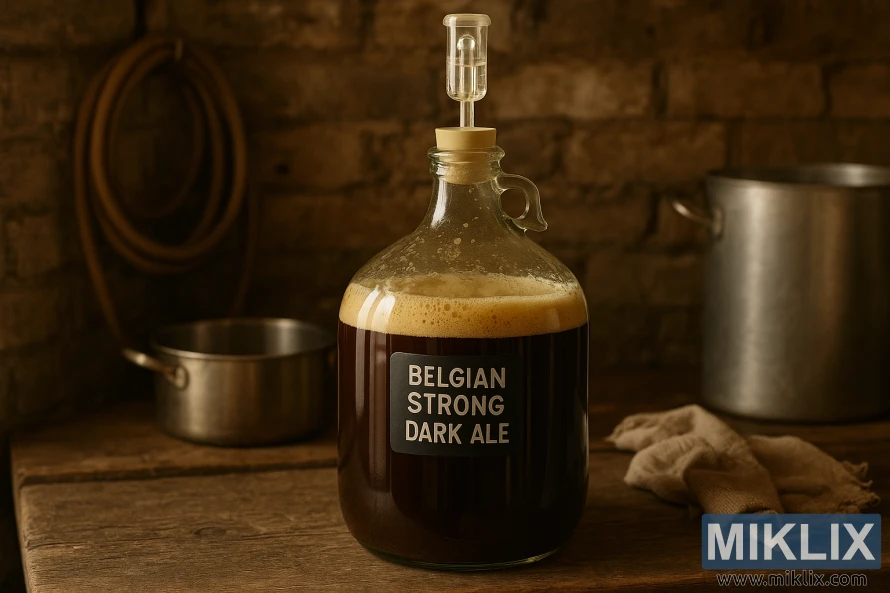
Recommended uses include Belgian Dark Strong Ale, Belgian Dubbel, Belgian Pale Ale, Tripel, and even cider. For homebrewers fermenting with WLP510, ordering with an ice pack during shipping preserves viability. This helps ensure a healthy pitch for high-gravity batches.
Key Takeaways
- White Labs WLP510 Bastogne Belgian Ale Yeast suits high-gravity and Belgian-style beers.
- Targets 66–72°F for clean fermentation with estery nuance.
- Attenuation generally falls between 74–80%, producing a drier finish.
- High alcohol tolerance makes it suitable for Tripels and Dark Strong Ales.
- Order White Labs Bastogne with an ice pack to protect yeast viability during shipping.
Overview of White Labs WLP510 Bastogne Belgian Ale Yeast
WLP510 overview: This Belgian ale yeast, originating from Bastogne/Orval, is celebrated for its dry finish and subtle acidity. It's ideal for Trappist-style beers. Its milder spice profile makes it versatile for both lighter and stronger brews.
Its performance is consistent across a broad gravity range. Attenuation ranges from 74–80%, with medium flocculation for decent clarity. Fermentation temperatures of 66–72°F (19–22°C) are recommended. It can handle high alcohol levels, often up to 15% ABV.
Compared to other strains, the Bastogne yeast profile is cleaner than WLP500 (Trappist Ale) and WLP530 (Abbey Ale). It has less phenolic spice than WLP530 or WLP550. This preserves the malt and ester flavors in complex ales.
It's suitable for a variety of beers, including Belgian Dark Strong Ale, Dubbel, Tripel, Pale Ale, and cider. Its high attenuation and alcohol tolerance make it ideal for both low-gravity table beers and high-gravity strong ales.
- White Labs yeast specs include availability in standard tubes and Vault format.
- Quality control records show STA1-negative results for this strain.
- Retailers advise shipping with ice packs to protect viability during transit.
Handling is straightforward: hydrate starters or pitch cleanly to meet gravity demands. The balanced profile and robust performance make WLP510 a dependable choice for a dry, slightly acidic Belgian character.
Why Choose White Labs WLP510 Bastogne Belgian Ale Yeast for Belgian Styles
WLP510 stands out for its ability to let yeast character take center stage without overwhelming malt and hops. Brewers appreciate the Bastogne yeast for its bright, fruity esters and clean, slightly tart finish. This makes it ideal for saisons, dubbels, tripels, and other Belgian styles.
The phenolic profile of WLP510 is mild, favoring spice over heavy clove or pepper. This makes it perfect for those who want fruit-forward notes to shine. Expect to find esters of pear, apple, and light banana, with restrained phenolics.
What sets WLP510 apart is its cleanliness and balance. It offers a cleaner fermentation character, allowing specialty malts and subtle hops to shine. Brewers often note better clarity in complex recipes when using WLP510.
Versatility is another key advantage. Bastogne yeast can handle high alcohol levels, making it suitable for a wide range of beers. This flexibility is invaluable for brewers aiming to create beers with varying original gravities.
Its historical ties to Orval-style strains also enhance its appeal. Brewers seeking authentic Trappist-like character find WLP510 provides a credible lineage. At the same time, it remains adaptable to modern recipe goals.
- Fruity ester emphasis for fruit-forward Belgian profiles
- Milder phenolics than strains like WLP530 or WLP550
- Cleaner fermentation that highlights malt and hops
- High alcohol tolerance for a wide range of strengths
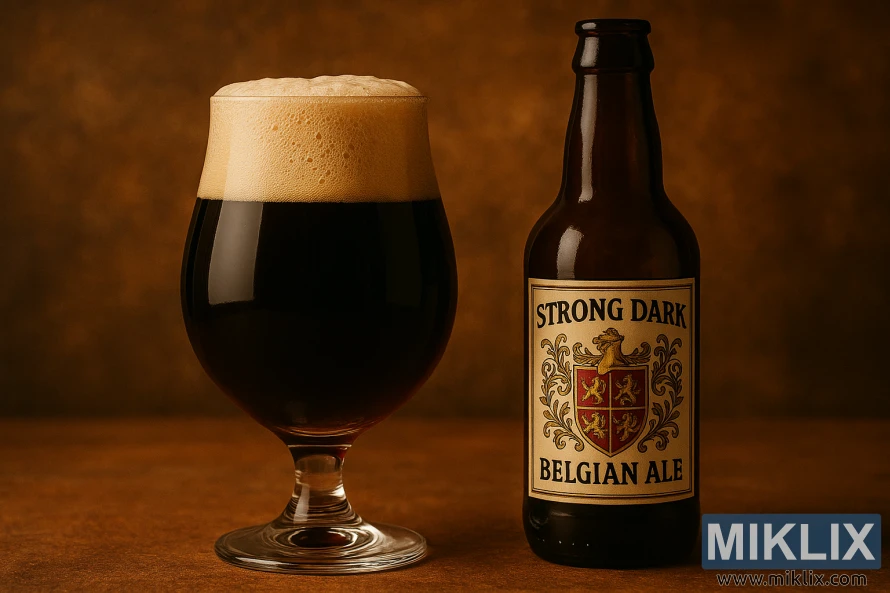
Recommended Fermentation Temperature and Environment
White Labs suggests fermenting WLP510 between 66–72°F (19–22°C). Begin at 66–68°F to encourage a cleaner ester profile and slower phenolic development. This approach allows brewers to manage flavor evolution during the early fermentation phase.
As fermentation progresses, allow a controlled rise to the upper end, up to 72°F, to enhance attenuation if necessary. Keep an eye on the fermenter's temperature, as the Bastogne environment can warm it several degrees above ambient. A gradual increase helps achieve the desired gravity without harsh fusels.
High-gravity worts tend to generate more heat and resist oxygen uptake. For robust Belgian ales, employing a fermentation chamber, swamp cooler, or jacketed fermenter is essential. This equipment helps control the fermentation environment for yeast strains in strong worts. Effective temperature management prevents excessive ester and fusel production.
Maintain a clean and stable brewing environment. Monitor the krausen height and core temperature with a probe or thermometer. A consistent Bastogne fermentation environment and attention to temperature fluctuations ensure yeast performance and batch reproducibility.
- Target: 66–72°F (19–22°C)
- Start low, allow controlled free-rise
- Use active temperature control for high-gravity beers
- Monitor krausen and fermenter temperature
Pitch Rate and Starter Recommendations
Pitch rate is key in Belgian ales, affecting ester and fusel production. For WLP510, aim for a balance to preserve esters and prevent harsh fusels.
The ale rule of thumb suggests 0.5–1.0 million cells per mL per degree Plato. Many experts agree on 0.75–1.0 million cells/°P·mL. For Bastogne styles, a common target is about 0.75 million cells.
Practical cell counts are essential for planning. For a 5-gallon (19 L) batch at OG 1.080, aim for roughly 284 billion cells. This ensures consistent fermentation in high-gravity beers.
Creating a yeast starter for Bastogne is necessary. A starter of about 0.75 gallons (2.8 L) from one White Labs tube can reach the needed cell count for a 1.080 wort. Ensure the starter is well oxygenated and given time to grow.
- Build starters with clean wort and good aeration to promote robust cell health.
- Use a stir plate or frequent shaking to maximize growth and limit stressed cells.
- Measure or estimate cell counts when brewing very high gravity beers to avoid underpitching.
Strategy depends on style goals. Slight underpitching can intensify esters for traditional Belgian character. Pitching to full calculated Belgian yeast cell counts produces a cleaner, more controlled profile.
For experimentation, split a batch and vary pitch rate between sections. Track results and repeat what yields the desired balance of fruit, spice, and attenuation for your Bastogne ale.
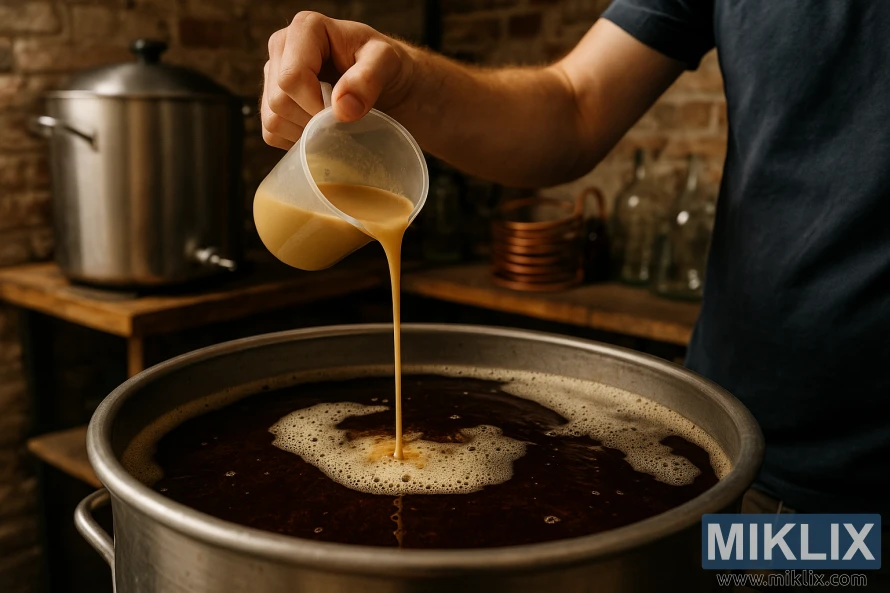
Oxygenation and Nutrients for Healthy Fermentation
Yeast need oxygen to create cell membranes and sterols before they start fermenting vigorously. For Belgian ales, aiming high is key because rich worts require more resources for healthy growth. Targeting dissolved oxygen levels at the upper end of the typical ale range supports strong, clean attenuation.
Experts recommend 12–15 ppm dissolved oxygen for Belgian ales, with 8–15 ppm as the typical range for ales. For high-gravity Bastogne-style beers, aiming closer to 15 ppm reduces the risk of stuck or stressed fermentations. It also limits harsh fusel alcohols.
Pure oxygen with a diffusion stone is the most reliable method for achieving these levels. A short pulse through a 0.5 micron stone can reach roughly 15 ppm in under two minutes. Hand-splashing or shaking usually produces around 8 ppm. Use oxygenation for the main wort and for starters when scaling up pitch size.
Starter oxygenation is as important as wort oxygenation. Yeast grown with adequate oxygen develop larger, fitter cell populations. This leads to faster ramp-up, steadier fermentation, and cleaner flavor profiles when using Bastogne yeast.
Nutrient recommendations for Bastogne yeast include enzymatic nutrient blends and mineral supplements. Products like White Labs Servomyces or a complete yeast nutrient help replenish vitamins and cofactors lost in simple adjunct worts. Add nutrients at pitch for best effect, and consider a follow-up dose if fermentation appears sluggish.
- Target dissolved oxygen Belgian ales: 12–15 ppm for strong worts.
- Use pure oxygen and diffusion stone for reliable WLP510 oxygenation.
- Oxygenate starters to build robust yeast populations.
- Follow nutrient recommendations Bastogne yeast with Servomyces or complete nutrient blends.
Careful attention to oxygen and nutrients reduces ester and fusel formation, improves attenuation, and preserves the classic Belgian profile that WLP510 can deliver. Small steps in oxygenation and nutrient management yield big gains in fermentation health.
Attenuation, Flocculation, and Expected Final Gravity
White Labs reports WLP510 attenuation at 74–80%. This means the yeast efficiently converts most wort sugars, aiming for a dry finish. This efficiency is key to the lighter body found in tripels and strong goldens.
WLP510 flocculation is classified as medium. It settles moderately, ensuring complete fermentation while allowing for decent clarity after conditioning.
To forecast the expected final gravity Bastogne, apply the attenuation range to your original gravity. For an OG of 1.080, expect an FG between 1.015 and 1.021. The actual FG will vary based on wort composition, dextrins, and simple sugar additions.
High attenuation results in a drier, slightly acidic finish. This dryness enhances the crispness on the palate. It also reduces residual sweetness and lightens the mouthfeel compared to lower-attenuating Belgian strains.
To achieve a fuller body, consider a malt bill with higher dextrin malts like Carapils or Munich. These malts counteract the drying effect, balancing the beer's profile for a richer mouthfeel while maintaining the characteristic dryness from WLP510 attenuation.
- Predictability: WLP510 attenuation offers a reliable FG range for recipe planning.
- Clarity: WLP510 flocculation results in good settling without premature flocculation.
- Style fit: The expected final gravity Bastogne aligns with dry, drinkable Belgian ales when adjusted properly.
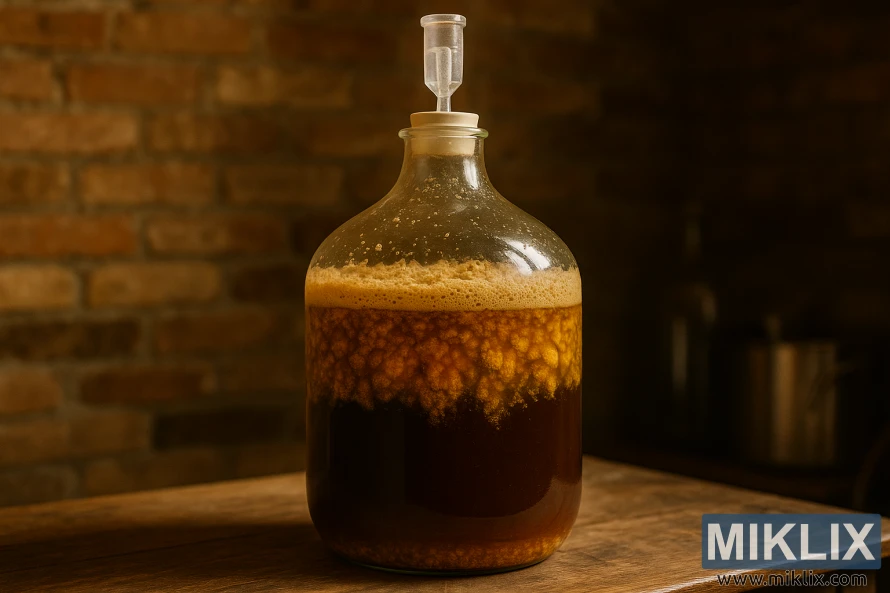
Alcohol Tolerance and High-Gravity Brewing with WLP510
White Labs classifies WLP510 as a high-tolerance Belgian strain, suitable for beers in the 10–15% ABV range. Brewers find it excels in finishing strong beers, where other strains falter.
To achieve success in high-gravity brewing with Bastogne, a robust starter is essential. Ensure healthy cell counts before pitching. High dissolved oxygen levels and proper nutrient feeding are also key for sustained fermentation.
For beers over 10% ABV, staggered sugar additions are recommended. Late candi sugar can help reduce osmotic stress early in fermentation. Split nutrient additions over the first few days to maintain yeast health.
High-gravity projects require longer primary and conditioning times. Regularly check gravity and be ready to extend aging. This allows for full attenuation and clean ester development.
- Pitching: larger starter or multiple packs for high OG wort
- Oxygen: 12–15 ppm dissolved oxygen at pitch
- Nutrients: staggered additions during active fermentation
- Temperature: steady control to avoid excessive phenolics or stalled ferment
With careful management, WLP510's alcohol tolerance makes it a reliable choice for strong Belgian Tripels and dark ales. Proper oxygenation, pitching, and nutrient strategy are vital. They help the yeast showcase its strengths in high-gravity brewing while avoiding off-flavors from stressed ferments.
Flavor Characteristics and How to Coax Desired Esters and Phenolics
The WLP510 flavor profile leans towards fruitiness, with notes of pear, plum, and a hint of citrus. It finishes dry and has a subtle spicy undertone. The yeast's phenolic spice is less pronounced, resulting in a balanced and accessible taste.
To manipulate esters and spice, brewers have three primary levers. Adjusting the pitch rate can significantly alter the flavor. A lower pitch rate tends to increase esters but also raises the risk of fusels. On the other hand, a higher pitch rate can mute esters, leading to a cleaner fermentation. It's essential to use the recommended cell counts to achieve a harmonious balance.
The fermentation temperature is another critical factor. Starting fermentation at a cooler temperature helps preserve cleaner esters. As fermentation progresses, a controlled increase in temperature can enhance attenuation and gently develop esters. Be cautious with temperature increases to prevent the formation of harsh off-flavors.
Oxygen levels play a significant role in yeast growth and metabolic processes. Aim for 12–15 ppm dissolved oxygen to promote healthy cell growth and reduce stress-induced fusels. Adequate oxygenation ensures consistent ester production without overbalancing the phenolics.
The composition of the wort also impacts the final product. The presence of simple sugars, such as candi sugar, can increase attenuation and dryness. This, in turn, can alter the perceived intensity of esters and the beer's body. Adjusting adjuncts can help achieve a lighter mouthfeel or a crisper finish.
- Pitch low + warmer finish: stronger fruit esters, watch for fusels.
- Pitch high + cooler profile: restrained esters, cleaner result.
- Moderate oxygen and nutrient regime: balanced fermentation and stable ester production.
Practically, brewers can split a batch to experiment with different variables. Varying the pitch rate and fermentation schedule across small fermenters allows for direct comparison. Blending the ferments can then refine the final product, combining the best of both worlds.
To effectively coax the desired esters and phenolics, keep detailed records of cell counts, temperature profiles, and oxygen levels. These records enable the repetition of successful brews and the refinement of Belgian yeast phenolics control in future batches.
Suggested Styles and Recipe Ideas for WLP510
WLP510 excels in a variety of Belgian styles. It's perfect for Belgian Dark Strong Ale, Dubbel, Belgian Pale Ale, Tripel, and even cider. These styles benefit from the strain's high attenuation and minimal phenolics.
For a strong golden or Tripel, begin with Pilsner base malt. Add a light adjunct sugar like cane or clear candi sugar. This boosts attenuation and dryness. Aim for an OG near 1.080 for a classic strong golden. A Bastogne recipe tripel made this way will have bright esters and a clean, warming alcohol presence.
In brewing a Belgian Dark Strong or Quadrupel, increase specialty malts like Special B and dark candi sugar. Optional additions such as raisins or baking spices can deepen the profile. Recipes with OG around 1.090 and FG near 1.020 show WLP510's ability to handle rich sugars and darker malt while maintaining robust fermentation.
For Dubbel recipes, focus on caramel and plum malts for a rounded malt backbone. Moderate attenuation balances sweet malt flavors with complex fruity esters. WLP510 recipe ideas for dubbels produce soft fruit esters and mild phenolics, perfect for classic monastery-style ales.
When brewing high-gravity batches, ensure strong oxygenation at pitch and use a generous starter or multiple pitches. Staggered nutrient additions support yeast health. Adjust the fermentation schedule for extended conditioning; many Belgian styles for WLP510 benefit from longer aging to meld flavors.
Try WLP510 in cider for a drier, slightly acidic profile with higher alcohol tolerance. Use standard cider sanitation and nutrient practices, then ferment clean and let the yeast finish dry. WLP510 recipe ideas for cider offer a beer-influenced take on traditional apple fermentations.
Sample checklist for recipe planning:
- Strong Golden/Tripel: Pilsner malt, light sugar, OG ~1.080, target dry finish — Bastogne recipe tripel approach.
- Belgian Dark Strong: darker malts, dark candi, OG ~1.090 for depth and warmth.
- Dubbel: caramel and Munich malts, moderate OG, focus on malt-fruit balance.
- Cider: nutrient, dry finish, use WLP510 for crispness and alcohol tolerance.
These options demonstrate WLP510's versatility. Use its strengths to tailor attenuation, ester profile, and final dryness across a range of Belgian-style brews.
Comparison with Other White Labs Belgian Strains and Practical Uses
WLP510 is positioned at the cleaner end of White Labs' Belgian offerings. It produces fruity esters with a dry, slightly acidic finish. This makes WLP510 ideal for those seeking restrained phenolics and clear fermentation character.
When choosing between WLP510 and WLP500, note that WLP500 offers richer esters and more complex fruitiness. It's perfect for dubbels and tripels. WLP510, on the other hand, provides a drier result with less spice, ideal for recipes requiring clarity.
In the comparison between Bastogne and Abbey Ale strains, Abbey-style yeasts like WLP530 deliver pronounced esters and peppery phenolics. These are reminiscent of Westmalle and Chimay. Use WLP530 or WLP550 for beers with strong spice and layered ester complexity. Opt for Bastogne when you prefer moderate spice and fruity notes.
White Labs Belgian strain comparison reveals distinct use cases:
- WLP500: complex esters, balanced phenolics for rich Belgian darks.
- WLP530: Westmalle-derived character, strong phenolics and esters.
- WLP550: Achouffe-like spice and big ester complexity.
- WLP570: Duvel-style, bright goldens with citrusy esters.
- WLP510: clean, fruity, drier finish with moderate phenolics.
Practical uses include single-strain lagers of character and blends. WLP510 is perfect for a fruity backbone without aggressive clove or pepper. It's suitable for higher attenuation grists and supports high-alcohol builds.
For added complexity, blend WLP510 with other Belgian strains or a yeast blend like WLP575. Small ratios of spicier strains can enhance phenolic lift while maintaining a cleaner base beer.
When aiming to emulate commercial profiles, select strains that match those targets. For Westmalle or Chimay-style beers, choose WLP530 or related strains. For Duvel-like goldens, consider WLP570. For a restrained, fruity Bastogne impression, opt for WLP510.
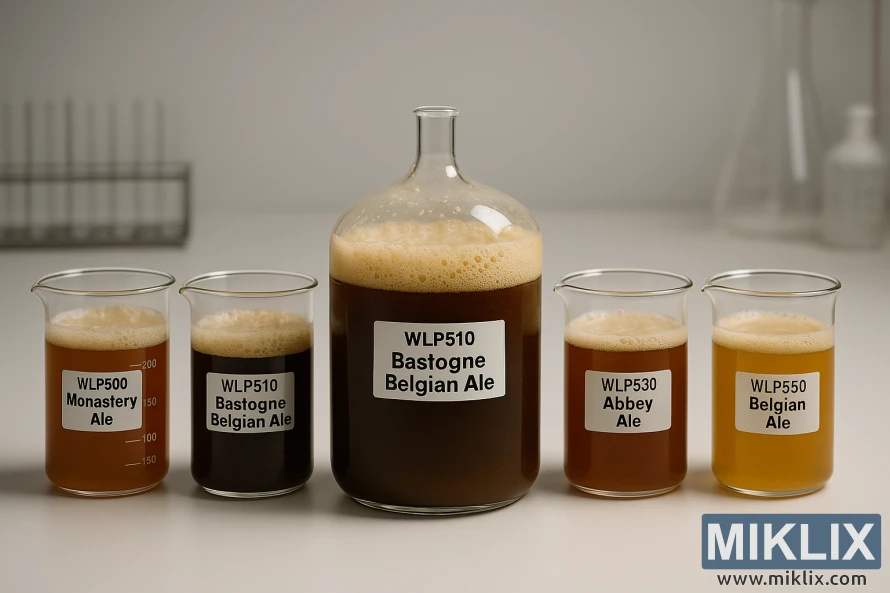
Practical Brewing Workflow with WLP510
Start by planning your brew day with a detailed WLP510 brewing workflow. Calculate the pitch rate using 0.5–1.0 million cells per °P·mL for your target original gravity. For higher gravities, prepare a starter to reach that pitch rate.
Design your malt bill to match the style. Use a pilsner base for goldens and tripels. For dark strong ales, choose darker malts and candi sugar. Chill the wort to 66–72°F before pitching.
Oxygenate the cool wort to 12–15 ppm for strong Belgian ales. Use pure oxygen with a stone for consistent results. Add a yeast nutrient like White Labs Servomyces as directed to support healthy ferment.
Pitch at the target temperature to shape ester and phenolic balance. For a cleaner profile, use a higher cell count. To encourage more esters, consider slight underpitching but beware higher fusel production risk. These choices form the core of how to ferment with Bastogne.
Monitor fermentation temperature closely. Allow a controlled free rise for more esters, but avoid uncontrolled overheating. Expect vigorous activity early, then a taper as yeast flocculates and the beer clears.
Condition high-gravity beers for an extended period. Cold crash or transfer to a secondary vessel if preferred. Bottle or keg only after full attenuation and sufficient maturation. The White Labs WLP510 process tends to finish dry and shows good attenuation for many Belgian styles.
Use this step-by-step outline to keep processes repeatable and predictable. A consistent WLP510 brewing workflow reduces variation and helps you dial in preferred profiles for each batch.
Common Troubleshooting Scenarios and Remedies
Stalled or slow fermentation is a frequent concern with Belgian ales. Causes include an insufficient pitch rate, low dissolved oxygen, weak nutrients, very high original gravity, or fermentation temperatures that are too low.
To fix stalled fermentation WLP510, prepare a larger starter or pitch additional healthy yeast. Oxygenate the wort well before pitching. Add yeast nutrient like Fermaid or Servomyces during the early stages. Raise the fermentation temperature gradually into the recommended range. For very high gravity beers, consider step-feeding simple sugars or staggered nutrient additions to keep yeast active.
Excessive esters or fusel alcohols often come from a too-low pitch rate, poor early oxygenation, or uncontrolled high fermentation temperatures. For WLP510 troubleshooting, increase pitch in future batches and control temperature with a fermentation chamber or temperature controller.
Overly phenolic or spicy character can be inherent to some Belgian strains and grows stronger with high temperatures. To manage Bastogne fermentation problems, start at the lower end of the yeast’s range and avoid sudden temperature spikes. If phenolics remain excessive, switch to a lower-phenolic strain for future brews and optimize pitch rate and oxygenation.
Poor attenuation or a high final gravity usually signals nutrient starvation, stalled yeast, or not enough viable cells for a high OG. To finish fermentation, re-pitch active yeast or a fresh starter and ensure proper oxygenation and nutrients in the next batch. Enzyme additions can help complex worts ferment more fully.
Yeast viability loss during shipping can ruin a brew day. Prevent this by ordering from reputable vendors and requesting cold-pack shipping when available. A viable package on arrival reduces the need for emergency WLP510 troubleshooting.
- Check gravity daily to spot stalls early.
- Keep a stir plate or spare starter on hand for emergency re-pitches.
- Maintain consistent temperatures with a controller or heated chamber.
- Document pitch rates, oxygen levels, and nutrient additions for each batch.
These practical remedies address common Bastogne fermentation problems and help fix stalled fermentation WLP510 without guesswork. Apply one change at a time to identify the most effective step for your system.
Purchasing, Storage, and Handling of WLP510
When you decide to buy WLP510, look for White Labs listings or trusted homebrew retailers in the United States. Product labels will show part number WLP510 and identify Bastogne Belgian Ale Yeast. Some shops offer White Labs tubes or the frozen Vault format. Retail prices vary; a few listings show low-cost single-tube options around $6.99, while bulk or specialty formats cost more.
Packaging matters. Tubes arrive refrigerated and retailers often include an ice pack for shipping. The frozen Vault format has different handling rules set by White Labs. Read the label before purchase so you know whether the shipment needs immediate refrigeration or thaw protocols.
Proper WLP510 storage keeps viability high. Store liquid tubes in the refrigerator and use before the expiration date. If you receive a Vault or frozen pack, follow White Labs guidance for thawing and transfer. Avoid repeated warming and cooling; temperature swings reduce cell health.
On receipt, keep product cold and plan to pitch promptly. For handling Bastogne yeast, avoid sudden temperature shocks when moving between fridge and wort. If the yeast is older or the cell count seems low, make a starter to restore vigor. A small starter can markedly improve fermentation performance and reduce lag time.
- Inspect packaging for cold chain integrity on arrival.
- If chilled, stash yeast in the fridge until brew day.
- If frozen, follow thaw and handling instructions from White Labs.
Quality control for WLP510 is well documented by White Labs; STA1 testing returns negative for this strain. Maintain standard sanitation during handling and pitching. Clean equipment and sterile technique protect yeast health and beer quality.
When planning multiple batches, label dates and track storage conditions. Good record keeping helps you decide when to build a starter versus direct pitch. Thoughtful handling Bastogne yeast yields consistent Belgian ales with the character brewers seek.
Conclusion
WLP510 Bastogne Belgian Ale Yeast is a standout for its versatility and high-gravity performance. It offers a dry, slightly acidic finish with fruit-forward esters and minimal phenolics. This makes it ideal for tripels, strong darks, and other high-ABV Belgian ales, providing a cleaner profile than many Trappist or abbey strains.
The yeast's strengths are evident in its alcohol tolerance, reaching up to 15% and higher. It also exhibits reliable attenuation, ranging from 74–80%, for a dry finish. Its medium flocculation ensures balanced clarity and mouthfeel. For optimal results, ferment between 66–72°F, use adequate starter sizes for high OG worts, and oxygenate to 12–15 ppm. Adding a nutrient like Servomyces is also beneficial.
WLP510 is the top choice for high-gravity Belgian beers in both homebrew and professional settings. It requires careful pitching, oxygenation, and temperature control to bring out desired esters without overemphasizing spice. It's also suitable for drier ciders. This yeast is a reliable option for brewers aiming to create powerful yet balanced Belgian beers.
Further Reading
If you enjoyed this post, you may also like these suggestions:
- Fermenting Beer with Wyeast 3726 Farmhouse Ale Yeast
- Fermenting Beer with Lallemand LalBrew Diamond Lager Yeast
- Fermenting Beer with Lallemand WildBrew Philly Sour Yeast
